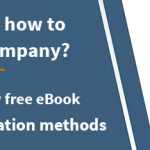Did a company for sale grab your attention? If you want to become an entrepreneur but feel like you do not have a base to do it, buying a company is a good option. Purchasing an existing company could be an opportunity to start a business without going through the process from scratch. As with everything, there are companies for sale that are not good buys. Therefore, there are professionals that accompany you in this journey and guide you in making the best decision.
Follow these steps to make sure you make the right purchase:
Step #1: Identify the industry you want to be in
The first step in an acquisition is defining the type of company that you are looking for. This begins with a broad decision on what industry you want to enter. You will have to investigate both the medium and long-term prospective of that sector, observe the competition, and pay attention to changes in laws and regulations. To really understand the service that the company offers, position yourself as a customer and experience it first-hand.
Step #2: Get in touch with the company for the acquisition
After a profound investigation, the next step is heading for the ideal company. While picking a company, it is important to have in mind a budget, size, location, annual income figure, and your possibilities for success. It should not offer you something you cannot handle. Therefore, counting on professionals is advised.
YOU MIGHT ALSO BE INTERESTED IN, “THE BUSINESS PLAN: THE PATHWAY TO BUY A COMPANY”.
Step #3: Start a negotiation
At this point, you already have a detailed image of the company and the industry. With this, you can begin the negotiations with the owners to come to the best deal possible for both parties. The first point of negotiation is the price – after performing a valuation. Then, you should formulate a plan for the rest of the process.
Step #4: Evaluate the company
The valuation stage in the purchase of a company is the most important to guarantee success. The assets sometimes make up the biggest part of any valuation. Depending on the company, this could be the value of the property and real estate or also the machinery and equipment. You should also not overlook the importance of the business volume, profitability, and current contracts.
Step #5: The purchase and sale agreement
The finalization of the purchase and sale contract marks the final stage of the acquisition. While both parties have already established a broad view of the purchase in general and non-legally binding terms, their purchase and sale agreement will impose legal obligations to both parties.
Step #6: The payment
There are various options to finance the purchase of a company, depending on the size and scale of the purchase. A large-size purchase (e.g. a multinational) could be a more complicated operation due to several factors. For a smaller-sized purchase, the most common payment method is net payment. The payment could come from private funds, investors, banks, other lending entities, etc. Sometimes, the actual owners may give up complete control of the company in the sale but only receive a percentage of the company value when sold – in exchange for a continued share of the company profits.
Conclusion
After these six steps, when the final documents are completed, contracts are signed, and payment agreement is official, the acquisition is complete. This process can be slow and take a lot of work; therefore, it is important to know that there are companies like ONEtoONE that can guide you and accompany you in the process.
YOU MIGHT ALSO BE INTERESTED IN, “THE STRATEGIC PLAN: THE KEY TO CREATING VALUE IN THE PURCHASE OF A COMPANY”.

This article was written by Enrique Quemada – President of ONEtoONE Corporate Finance.















